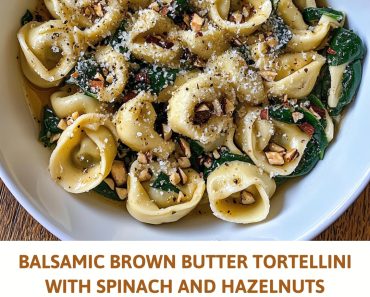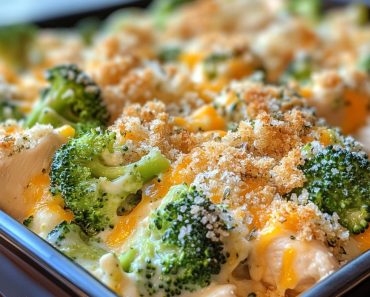
Ham and Cheese Puff Pastry Pockets
Bring a sense of warmth and comfort to your kitchen with these Ham and Cheese Puff Pastry Pockets. Perfectly flaky, buttery pastry envelopes a hearty filling of savory ham, gooey cheddar cheese, and crisp vegetables. These pockets are a quick and satisfying option for breakfast, brunch, or even an afternoon snack. Easy to make and beautifully customizable, this recipe will become a family favorite.
Ingredients Overview
Let’s take a closer look at the key ingredients that bring this dish to life:
- Puff Pastry: This flaky and buttery base is the star of the show. Store-bought puff pastry is convenient and reliable, but ensure it’s thawed properly for easy handling.
- Diced Ham: Choose quality ham for the best flavor. Leftover holiday ham or deli-sliced works great.
- Shredded Cheddar Cheese: Sharp cheddar adds depth, but you can experiment with Swiss, Gruyère, or mozzarella.
- Red Bell Pepper: This adds a pop of sweetness and crunch to balance the savory ham and cheese.
- Green Onions: Their mild, oniony bite enhances the overall flavor profile without overpowering.
- Egg: Acts as a natural glue to seal the pockets and provides a golden, glossy finish.
- Seasonings (Salt and Pepper): Adjust to taste, but remember the ham and cheese bring saltiness, so less is more.
Step-by-Step Cooking Instructions
1. Preheat and Prep
Preheat your oven to 400°F (200°C). Line a baking sheet with parchment paper to ensure your pockets don’t stick and clean-up is a breeze.
2. Roll Out the Puff Pastry
On a lightly floured surface, roll out your puff pastry to smooth out any creases. Using a sharp knife or pizza cutter, divide it into 6 equal squares.
3. Prepare the Filling
In a medium mixing bowl, combine 1/2 cup diced ham, 1/2 cup shredded cheddar cheese, 1/4 cup diced red bell pepper, and 1/4 cup chopped green onions. Add salt and pepper to taste. Mix until evenly distributed.
4. Assemble the Pockets
Place a generous spoonful of the filling on one half of each pastry square. Fold the opposite side over the filling to form a triangle. Use a fork to crimp the edges tightly, sealing in the filling.
5. Egg Wash Magic
Brush the tops of the pastry triangles with beaten egg for a golden finish. This step also ensures a professional look and enhances the flavor.
6. Bake to Perfection
Place the pockets on the prepared baking sheet. Bake for 15-20 minutes, or until the pastry is puffed and golden brown. Let them cool slightly before serving to avoid burns from the hot filling.
Valuable Tips for a Seamless Cooking Experience
- Thaw Puff Pastry Correctly: Let it sit in the fridge overnight or at room temperature for 30 minutes.
- Don’t Overfill: Avoid overloading the pockets to prevent spillage during baking.
- Seal Tightly: Ensure the edges are well-crimped to avoid leaks.
- Customize Fillings: Try spinach and feta, mushrooms, or chicken and broccoli for variety.
- Use Fresh Ingredients: Fresh vegetables and cheese elevate the flavor.
Storage and Reheating Tips
- Storage: Allow the pockets to cool completely, then store in an airtight container in the fridge for up to 3 days.
- Freezing: Wrap uncooked pockets individually in plastic wrap and freeze. Bake from frozen at 375°F for 25-30 minutes.
- Reheating: Warm leftovers in an oven at 350°F for 5-7 minutes to retain crispiness. Avoid microwaving as it softens the pastry.
20 Frequently Asked Questions (FAQs) About Ham and Cheese Puff Pastry Pockets
1. Can I use homemade puff pastry instead of store-bought?
Absolutely! Homemade puff pastry adds a personal touch, but it’s more time-consuming.
2. Can I use other types of meat?
Yes, shredded chicken, turkey, or cooked bacon work wonderfully as substitutes.
3. Can I make vegetarian versions?
Swap the ham for sautéed mushrooms, spinach, or roasted vegetables for a vegetarian-friendly option.
4. What’s the best way to thaw puff pastry?
Let it thaw in the refrigerator overnight or at room temperature for 30-40 minutes. Avoid microwaving, as it can make the pastry unevenly soft.
5. Can I use frozen vegetables?
Yes, but thaw and pat them dry first to avoid excess moisture.
6. Do I have to brush with egg wash?
Egg wash gives a glossy, golden finish, but milk or cream can be used as an alternative.
7. Can I make these in advance?
Yes! Assemble the pockets, cover them tightly, and store in the fridge for up to 24 hours before baking.
8. How do I prevent the filling from spilling out?
Don’t overfill, and ensure the edges are tightly sealed with a fork.
9. Can I freeze these after baking?
Yes, allow them to cool completely, then freeze in a single layer before transferring to an airtight container.
10. How do I reheat them without losing crispiness?
Reheat in an oven or air fryer at 350°F for a few minutes. Avoid microwaving as it softens the pastry.
11. What if I don’t have parchment paper?
Use a silicone baking mat or lightly grease the baking sheet.
12. Can I add sauces inside the pockets?
Yes, but use sparingly to avoid soggy pastry. Mustard or a thin layer of béchamel works well.
13. How do I make them extra crispy?
Bake them on the middle rack and ensure the oven is fully preheated before baking.
14. Can I double the recipe?
Definitely! Simply multiply the ingredients and bake in batches if needed.
15. Can I make these gluten-free?
Yes, use gluten-free puff pastry, available at specialty or health food stores.
16. How do I ensure even cooking?
Rotate the baking sheet halfway through baking for even browning.
17. Can I serve these cold?
While they taste best warm, they can be enjoyed cold as a quick snack.
18. What’s the best cheese to use?
Sharp cheddar is classic, but Gruyère, Swiss, or Monterey Jack are excellent alternatives.
19. How can I add a spicy kick?
Mix in diced jalapeños, red pepper flakes, or a pinch of cayenne pepper.
20. Are there any low-calorie substitutions?
Use reduced-fat cheese, turkey ham, and phyllo dough for a lighter version.
20 Secrets to Culinary Perfection
1. Keep the Puff Pastry Cold
Chilled pastry is easier to handle and results in a flakier texture.
2. Roll Gently
Avoid overworking the pastry as it can compress the layers and reduce puffiness.
3. Use Fresh Ingredients
Freshly diced ham, crisp bell peppers, and vibrant green onions enhance flavor.
4. Grate Cheese Fresh
Pre-shredded cheese often contains anti-caking agents, which affect melting.
5. Sauté Vegetables
Cook the bell peppers and green onions lightly for a softer filling with enhanced flavor.
6. Cut Ventilation Slits
Cut small slits on top of each pocket to allow steam to escape and prevent bursting.
7. Seal Edges Properly
Crimp the edges firmly with a fork or use an egg wash as glue for a tight seal.
8. Experiment with Seasonings
Try garlic powder, smoked paprika, or Italian herbs for added flavor.
9. Use Quality Ham
Opt for honey-glazed or smoked ham for a richer taste.
10. Add a Touch of Mustard
Spread a thin layer of Dijon mustard inside for a subtle tang.
11. Preheat the Oven Fully
Ensure your oven is fully preheated to 400°F for even cooking and crisp pastry.
12. Use a Convection Setting
If available, a convection oven promotes even browning.
13. Avoid Overfilling
Stick to the recommended amount of filling to prevent leakage.
14. Brush the Entire Surface
Coat all visible pastry with egg wash for an evenly golden crust.
15. Bake on the Middle Rack
This ensures optimal heat circulation for evenly puffed pastry.
16. Test Doneness with the Bottom
Check the underside of the pastry to ensure it’s golden and fully cooked.
17. Freeze Before Baking (Optional)
For better structure, freeze the assembled pockets for 10 minutes before baking.
18. Line the Baking Sheet
Use parchment paper or a silicone mat to prevent sticking and ensure easy cleanup.
19. Let Cool Before Serving
Allow the pockets to rest for a few minutes to avoid burning from hot filling.
20. Serve with Dips
Pair with honey mustard, ranch, or marinara sauce for added flavor and versatility.
These FAQs and secrets ensure your Ham and Cheese Puff Pastry Pockets turn out perfectly every time, leaving your guests impressed and craving more




















